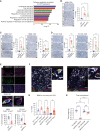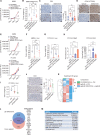A Cancer Cell-Intrinsic GOT2-PPARδ Axis Suppresses Antitumor Immunity
- PMID: 35894778
- PMCID: PMC9533011
- DOI: 10.1158/2159-8290.CD-22-0661
A Cancer Cell-Intrinsic GOT2-PPARδ Axis Suppresses Antitumor Immunity
Abstract
Despite significant recent advances in precision medicine, pancreatic ductal adenocarcinoma (PDAC) remains near uniformly lethal. Although immune-modulatory therapies hold promise to meaningfully improve outcomes for patients with PDAC, the development of such therapies requires an improved understanding of the immune evasion mechanisms that characterize the PDAC microenvironment. Here, we show that cancer cell-intrinsic glutamic-oxaloacetic transaminase 2 (GOT2) shapes the immune microenvironment to suppress antitumor immunity. Mechanistically, we find that GOT2 functions beyond its established role in the malate-aspartate shuttle and promotes the transcriptional activity of nuclear receptor peroxisome proliferator-activated receptor delta (PPARδ), facilitated by direct fatty acid binding. Although GOT2 is dispensable for cancer cell proliferation in vivo, the GOT2-PPARδ axis promotes spatial restriction of both CD4+ and CD8+ T cells from the tumor microenvironment. Our results demonstrate a noncanonical function for an established mitochondrial enzyme in transcriptional regulation of immune evasion, which may be exploitable to promote a productive antitumor immune response.
Significance: Prior studies demonstrate the important moonlighting functions of metabolic enzymes in cancer. We find that the mitochondrial transaminase GOT2 binds directly to fatty acid ligands that regulate the nuclear receptor PPARδ, and this functional interaction critically regulates the immune microenvironment of pancreatic cancer to promote tumor progression. See related commentary by Nwosu and di Magliano, p. 2237.. This article is highlighted in the In This Issue feature, p. 2221.
©2022 The Authors; Published by the American Association for Cancer Research.
Figures





Comment in
-
GOT2 consider the tumor microenvironment.Trends Cancer. 2022 Nov;8(11):884-886. doi: 10.1016/j.trecan.2022.09.004. Epub 2022 Sep 21. Trends Cancer. 2022. PMID: 36153305 Free PMC article.
-
GOT2: An Unexpected Mediator of Immunosuppression in Pancreatic Cancer.Cancer Discov. 2022 Oct 5;12(10):2237-2239. doi: 10.1158/2159-8290.CD-22-0845. Cancer Discov. 2022. PMID: 36196574
References
Publication types
MeSH terms
Substances
Grants and funding
LinkOut - more resources
Full Text Sources
Medical
Research Materials
Miscellaneous

